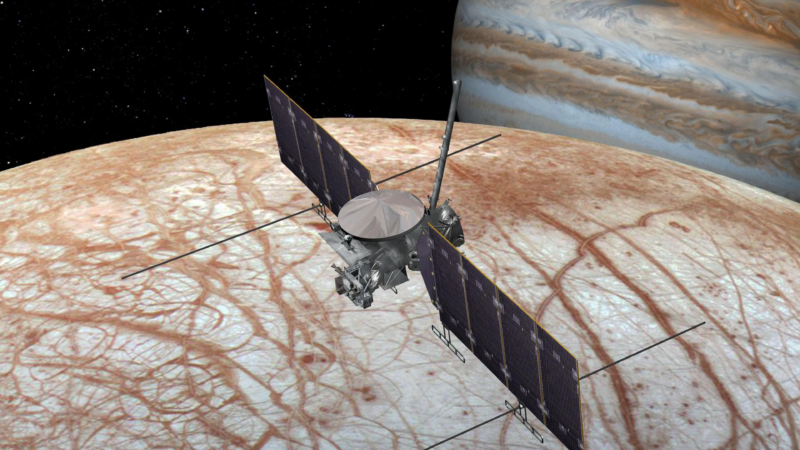A NASA probe is about to launch to an icy moon that could have life
A long-awaited mission to an icy moon of Jupiter is on track to launch in just a few weeks, NASA officials said Tuesday in an event previewing the launch.
The moon, Europa, is thought to have conditions that are right for life–but with a catch.
Any life would likely be hidden away beneath a deep global ocean, plus a layer of surface ice that could be over ten miles thick. So for this mission, researchers won’t be searching for life itself.
“We’re looking for chemicals on the surface, organic chemicals that are the precursors to life,” says Bonnie Buratti, deputy project scientist for NASA’s Europa Clipper mission.
Scientists have already gathered lots of evidence that suggest the ingredients for life exist on Europa, like the water in its subsurface ocean, she says, “but we have to go there to find out.”
NASA aims to launch Europa Clipper during a window that opens on October 10, on a SpaceX Falcon Heavy rocket.
“We scientists have been dreaming about a mission like Europa Clipper for more than twenty years. We’ve been working to build it for ten years,” notes Laurie Leshin, the director of NASA’s Jet Propulsion Laboratory. “It’s going to be another ten years—because Jupiter is so far away—until we have all the science in the bag. It really is a very long term investment and quest.”
The spacecraft’s 1.8-billion-mile trek out to Jupiter will take over five years. Once it’s there, it will spend several years making dozens of close flybys of Europa.
“We’re not landing on Europa. We do get as close as 25 kilometers above the surface, that’s about 16 miles,” says Jordan Evans, the mission’s project manager.
Europa Clipper is fitted with massive solar panels because Jupiter is so much farther from the sun than Earth. The spacecraft’s solar panels extend out like a pair of wings that together span about 100 feet, making this the biggest interplanetary probe that NASA has ever built and launched.
One challenging part of this mission has been making sure that the spacecraft will be able to withstand the intense radiation around Europa, says Evans.
During each flyby, he says, “the surface of the spacecraft is exposed to the equivalent of a few million chest X-rays. And yet the Europa Clipper instruments have to be sensitive enough to gather the critical information that scientists need to learn about the moon.”
Europa is about the size of the Earth’s moon, but its surface has very few craters, suggesting that some kind of active geologic processes have been working to erase them.
The moon was first discovered by the famous astronomer Galileo Galilei in 1610, and a NASA spacecraft named after him later flew by and discovered that Europa was likely to have a subsurface ocean.
The moon’s icy surface is crisscrossed by mysterious dark streaks, and it has so-called “chaos terrains” filled with cracks and fissures.
Europa Clipper’s suite of on-board instruments, including ice-penetrating radar and high-resolution cameras, should help scientists make better sense of this geologic jumble, letting them untangle how the subsurface ocean could interact with the icy layers above.
“There are, you know, dream things we could observe, like DNA or RNA. But we don’t expect to see those,” says Buratti. “It really is just looking for a habitable environment and evidence for the ingredients of life, not life itself.”
Once the mission is over, managers say that Europa Clipper will be directed to crash land on another moon, Ganymede. Like Europa, Ganymede is thought to have an interior ocean, but it does not appear to be in contact with the surface.
Ganymede is the main target of a European spacecraft, JUICE, which launched last year and which is expected to arrive at Jupiter in 2031. That means, potentially, JUICE could watch as Europa Clipper plows into this moon.
“A lot of things can happen between now and the end of Europa Clipper’s mission,” says Evans, “but that would certainly be the possibility.”
Sterlin Harjo didn’t see himself in the TV shows he watched – so he made one
When Sterlin Harjo was growing up, he didn't see many Native Americans in mainstream media. But Sterlin's TV show, Reservation Dogs, changed that, depicting the lives of four Native teenagers growing up in Oklahoma. Sterlin talks to Rachel about how he thinks fate has guided his life, why people should go to more funerals and how hunting feels like praying.To listen sponsor-free, access bonus episodes and support the show, sign up for Wild Card+ at plus.npr.org/wildcard
Inside the Brooklyn jail where Sean Combs is locked up: violence, squalor and death
As they fought to keep Sean "Diddy" Combs out of jail after his sex trafficking arrest, the music mogul's lawyers highlighted a litany of horrors at the Brooklyn federal lockup where he was headed.
GPB evening headlines for September 18, 2024
Prosecutors have dropped some charges against three people indicted in connection with Atlanta police training center protests. The two candidates for district attorney in Savannah's Chatham County clashed over experiences and records in a forum this week. Georgia's Supreme Court is rejecting an effort to force new Republican primary elections in northwest Georgia's Catoosa County.
Forget tedious paper applications, Americans can now renew passports online
The State Department announced Wednesday that its online renewal system is now fully operational, after testing in pilot programs, and available to adult passport holders whose passport had expired within the past five years or will expire in the coming year.
Vance says Haitian migrants with protected status are ‘illegal aliens’ to be deported
The Republican vice presidential nominee continues to rail against Haitian migrants living in Ohio, though many have Temporary Protected Status, as the GOP escalates its hardline immigration stance.
The latest on the Land Back movement, in which Native American tribes reclaim land
The Land Back Movement is an effort by native Americans to reclaim lost land. Two reporters take a look at where it’s worked and where it hasn’t at reservations in Minnesota.





